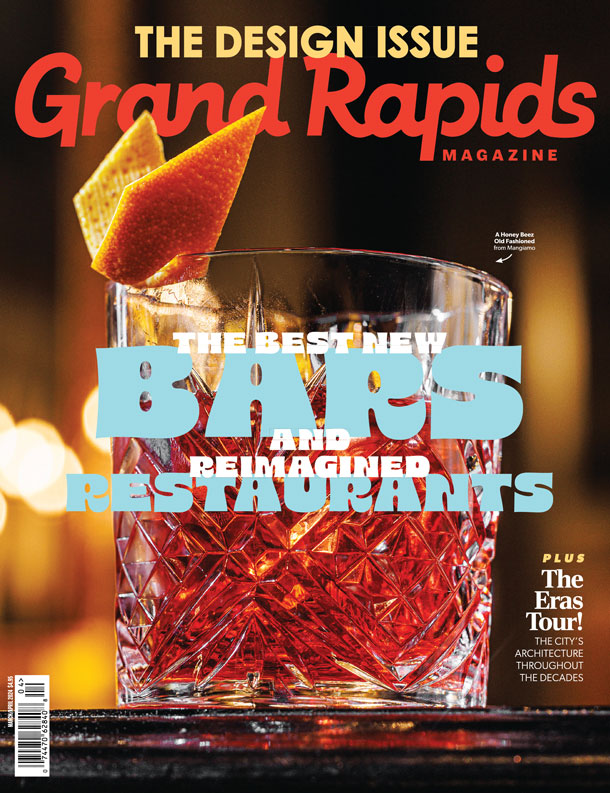“As much as it’s important to give, I remembered it’s also important to know how to receive.”
This was Reb Roberts’ response after receiving the 2018 Guy Bazzani Local Legacy Award. Local First honored Roberts during the organization’s 8th Annual Meeting at the Goei Center on Jan. 25.
Elissa Hillary, president of Local First, said, “Reb is a living example of our mission and what it means to support local. On behalf of the Local First board of directors, we are honored to recognize Reb and to celebrate everything he has done to use art as a force for good in our community.”
While Roberts, a local folk artist, had put together children’s art activities and live painting events for years at the annual Local First street party, he never thought about being recognized for his efforts. “I always feel as if my work gives to me,” he says. “It’s wonderful and surprising when people acknowledge what your efforts are giving to them.”
Roberts is a long-time supporter of Local First efforts, which challenge the community to support local businesses, as he owned Sanctuary Folk Art Gallery on Division Ave. for 18 years. While the gallery was a strong presence amid downtown development, it closed gracefully in October 2017. Roberts credits much of his successes as a business owner and artist to what he calls the “hugely benevolent community” of Grand Rapids.
Roberts’ humble and unassuming nature belies the huge impact he has had on the city, particularly in the realm of what he calls “tactical street art.” He recounts how in the mid-‘90s, driving down Wealthy Street from Eastown to downtown meant traveling an expanse of boarded-up buildings.
That’s when he decided to create the fish mural that still stands between Charles and Henry Streets along Wealthy Street that had an attached sign reading “Developing Soon.” Even though nothing specific was developing at the time, Roberts wanted to give hope to those living near closed buildings and to “put a question mark in people’s heads.”
This was the beginning of Roberts’ painting career, which in part involved creating murals and art in many blighted city neighborhoods. He knew that the art would most likely be temporary, and preferred to work hand in hand with people in the community to give it life, especially neighbors living in construction zones who looked at abandoned buildings on a daily basis.
Today, he’s widely recognized as an important artist and community activist. “Reb has created some of the most iconic murals and street art in Grand Rapids,” says Rosalynn Bliss, mayor of the City of Grand Rapids. “More than that, he has become a pillar by serving our community and bringing out the best in us for decades.”
What life experiences gave Roberts the insight and perspective to seek to improve the lives of urban residents? Prior to his start as an artist, for twenty years Roberts served as an early education teacher and coordinator of Head Start programs. As he worked closely with families, he explains that he got acquainted with a sort of “richness.”
Even though many families didn’t have a lot of money, Roberts explains that they found ways to beautify their businesses and homes, whether it was through hand-painted signs or tires painted purple and planted with flowers.
Roberts became enchanted with the “vernacular of the city,” which he describes as very beautiful and at risk of being lost. He saw art as a means for “people to stay connected to their lives when things are messy.” Throughout developing parts of the city, Roberts began asking himself “how can we make this place shine before we have the means and money?”
Since closing his gallery, Roberts is taking his time to look through old notebooks for old ideas and also to “reintroduce himself to the city.” He’s driven through developing areas, including Bridge Street, Creston, Alger Heights, Boston Square, and Eastern Avenue just south of Wealthy. He says he senses a little void in each neighborhood, as some buildings still stand vacant.
“What does it feel like to live on a street where something sits empty?” he asks. Roberts quickly answers: “I feel that creates a stigma. It leaves people wishing and hoping.”
As he surveys the many possible sites for his next project, he remembers a time when he found himself standing in a pocket of rain in a parking lot.
“I can’t rain everywhere at once, but I can do something small.”








Facebook Comments